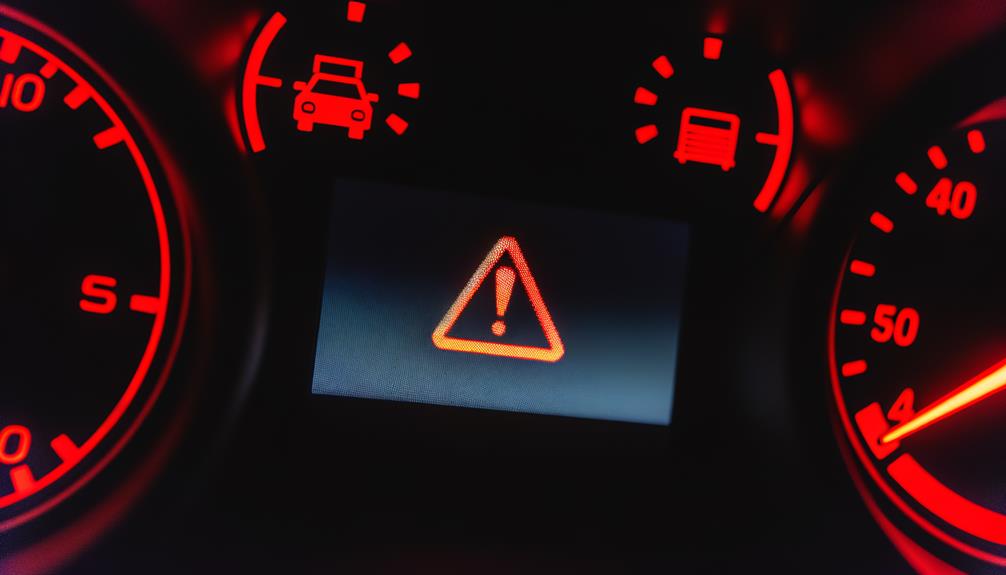What Is the Meaning of the Exclamation Mark Light in Your Car?
An exclamation mark symbol on your car's dashboard commonly indicates important alerts regarding essential systems such as the Tire Pressure Monitoring System (TPMS), Traction Control System (TCS), or Electronic Stability Control (ESC). For instance, it may signal that the tire pressure is below the manufacturer's recommended level, which can impact vehicle performance and safety.
Additionally, it might be pointing to issues in the brake system, such as low brake fluid or hydraulic system failures. Immediate professional inspection is advisable to ensure vehicle safety and longevity.
Understanding these indicators is crucial for maintaining top-notch vehicle performance. Keep exploring to gain thorough insights.

Key Takeaways
- The exclamation mark symbol often indicates a critical issue with the vehicle's systems.
- It commonly signifies tire pressure monitoring system (TPMS) alerts.
- The symbol can also indicate traction control system (TCS) issues.
- An exclamation mark may warn of electronic stability control (ESC) malfunctions.
- Immediate attention to brake system alerts is crucial for vehicle safety.
Dashboard Warning Symbols

Dashboard warning symbols are critical indicators that provide drivers with essential information about the operational status and potential issues of their vehicle systems. These symbols, often illuminated on the instrument cluster, encompass a wide range of alerts, from minor notifications to severe warnings that necessitate immediate attention.
The icons are designed to convey specific system statuses, such as engine performance, battery health, and brake functionality. A thorough comprehension of these symbols is indispensable for maintaining vehicle safety and performance.
Each symbol's color is also indicative of the urgency, with red often denoting critical issues and yellow or orange signaling caution. Mastery of these warnings allows drivers to address problems promptly, thereby mitigating risks and optimizing vehicle longevity.
Common Exclamation Mark Meanings
Among the myriad dashboard warning symbols, the exclamation mark stands out due to its association with several critical vehicle functions requiring prompt driver attention. Typically, this symbol can indicate tire pressure monitoring system (TPMS) alerts, traction control system (TCS) issues, or problems within the electronic stability control (ESC).
In the context of TPMS, an illuminated exclamation mark suggests tire pressure deviation from the manufacturer's recommended levels, necessitating immediate inspection. For TCS, it may indicate a system malfunction, compromising road grip and vehicle stability. Similarly, ESC-related alerts demand immediate attention to prevent potential loss of control during adverse driving conditions.
Understanding these meanings guarantees timely intervention, enhancing vehicle safety and performance.
Brake System Alerts

The exclamation mark symbol in the context of brake system alerts signifies critical issues such as low brake fluid levels, malfunctioning brake system components, or potential hydraulic system failures, all of which necessitate immediate professional inspection and intervention. This warning indicator is a crucial safety feature designed to alert drivers to conditions that could severely impair braking performance.
Low brake fluid levels could indicate leaks or worn-out brake pads, while hydraulic system failures may compromise the integrity of the braking mechanism. Prompt attention to this warning can prevent brake failure, which is paramount for vehicle safety.
Utilizing OEM diagnostic tools and adhering to manufacturer-recommended maintenance schedules are essential steps in ensuring the brake system remains in top operating condition.
Tire Pressure Warnings
Monitoring tire pressure is crucial for vehicle performance, safety, and fuel efficiency. The tire pressure warning light, often represented as an exclamation mark in a horseshoe-shaped symbol, alerts drivers to less than ideal tire pressure conditions. This indicator is part of the Tire Pressure Monitoring System (TPMS), which continuously measures and reports tire pressure.
Underinflated tires can lead to increased rolling resistance, resulting in poor fuel economy and compromised handling. Conversely, overinflated tires reduce traction and increase wear. Maintaining manufacturer-recommended tire pressure ensures optimal contact with the road surface, enhancing braking effectiveness and stability.
Accurate tire pressure contributes to even tread wear, extending tire life and reducing the risk of blowouts, thereby safeguarding occupants and improving overall vehicular reliability.
Immediate Actions to Take

Upon illumination of the tire pressure warning light, drivers should promptly check and adjust their tire pressures to the manufacturer's specifications to ensure peak vehicle performance and safety.
This involves using a reliable tire pressure gauge to measure each tire's PSI (pounds per square inch) and comparing it to the recommended levels found in the vehicle's owner manual or the placard located on the driver's side door jamb. If discrepancies are detected, drivers should either inflate or deflate the tires accordingly.
It is essential to inspect all tires, including the spare, as underinflation can lead to reduced fuel efficiency, compromised handling, and increased tire wear. If the warning persists, a professional diagnostic check may be necessary to rule out sensor malfunctions.
Conclusion
The exclamation mark on a car's dashboard is an unmistakable sentinel, signaling critical issues that demand immediate attention. Often associated with brake system alerts and tire pressure warnings, this symbol's appearance foretells potential driving hazards.
Understanding these warnings is crucial for maintaining vehicular safety and performance. Ignoring such indicators could lead to catastrophic outcomes, turning a minor issue into a vehicular apocalypse.
Timely and precise response to these alerts is crucial for efficient automotive operation and safety.






